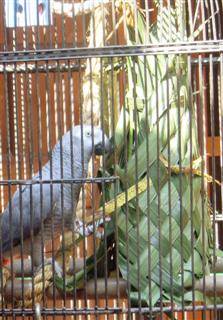Keeping your pets active and happy
 Animals kept in captivity can become bored. An animal that is not stimulated is unhappy. Pacing and other repetitive motions are common, as are aggressive behavior, psychological damage, and simple inactivity. These destroy one’s enjoyment of any pet. This problem is faced by zoos, as well as private pet owners. One solution – or, rather a broad range of sub-solutions – to keep your animals stimulated is enrichment.
Animals kept in captivity can become bored. An animal that is not stimulated is unhappy. Pacing and other repetitive motions are common, as are aggressive behavior, psychological damage, and simple inactivity. These destroy one’s enjoyment of any pet. This problem is faced by zoos, as well as private pet owners. One solution – or, rather a broad range of sub-solutions – to keep your animals stimulated is enrichment.What is enrichment?
Enrichment is any activity that stimulates captive animals to display normal behaviors; behaviors that mimic their daily activities in the wild. Tying a ribbon on a string and hanging it up for a cat to play with is simple enrichment. In trying to “catch” the ribbon, the cat mimics the natural activity of catching food.There are three main types of enrichment:
- Environmental enrichment: providing your pets with an enclosure that permits exploration, foraging, ‘destruction’ (explained later), etc. My birds (with the exception of the Java Rice Finch) all enjoy a spray from a hand mister on hot days, even though a water bath is always available in all my cages.
- Sound enrichment: my lovebirds love to whistle along to any creaking noise or whistle. I keep them in a place where they can hear and see wild birds (if you’ve kept lovebirds you’ll probably have realized that the primary purpose in their lives is to rip other birds limb from limb, so watching wild finches in my garden gives my lovebirds quite a thrill). Sound enrichment doesn’t work with snakes… (although I’ve never tried it with other reptiles).
- Olfactory enrichment: Many animals have keen senses of smell and will spend hours investigating a new scent. This can be used with ferrets, rats, chinchillas, etc. I’ve never used it with birds or reptiles (and I do not suggest using it with amphibians – most scents are chemicals and amphibians can absorb chemicals through their skin). I’ve personally never used it with my pets. Now that I think of it, my mouse would probably enjoy it. Anybody got any suggestions or scents mice find attractive (I’m not too keen on using food).
The limiting factor with enrichment is you imagination. Obviously, make sure you don’t use something dangerous. If you use plants ensure that they are not toxic in any way. And make sure you do not feed live prey as ‘enrichment!’ While certain animals must be given live food, it would be unquestionably unethical to do so for simple pleasure. Otherwise, be creative and enjoy watching your pet enjoy your enrichment…


0 Comments:
Post a Comment
<< Home